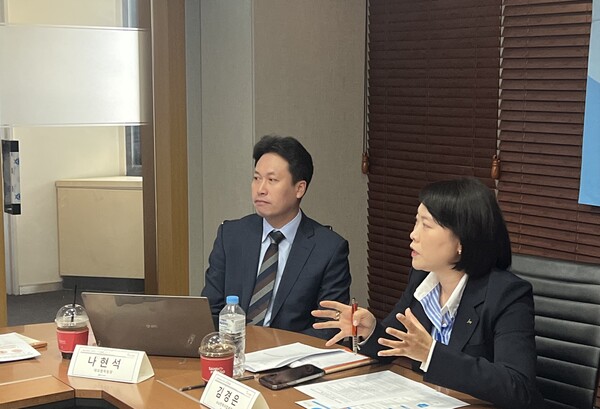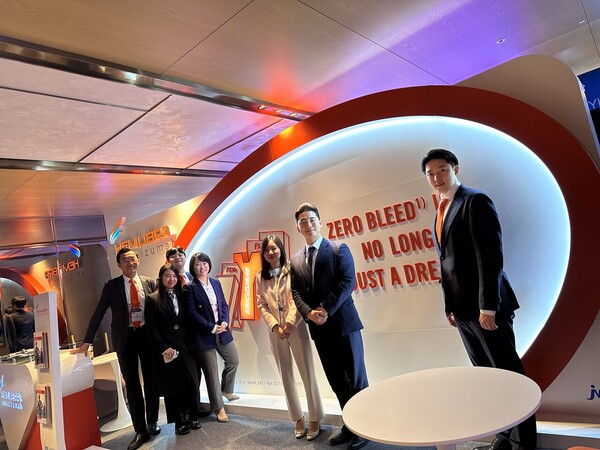“There was this child who always stayed at home because he had to rush to the emergency room frequently, although he received intravenous hemophilia injections every two or three days. Now the child attends kindergarten, as he rarely goes to the hospital after receiving the Hemlibra injection. When I heard the story from the patient’s mother, I felt proud and rewarded.”
So said Kim Kyeong-eun, head of JW Pharmaceutical’s Bio Business Strategy Department, in a meeting with journalists on Monday to discuss Hemlib subcutaneous injection’s antibody reimbursement.
Ahead of its market release, the company had supported the injection to patients free of charge for years.
Starting this month, Hemlibra’s reimbursement was expanded to non-antibody severe hemophilia A patients aged one and older. In May 2020, it won the first reimbursement as a preventive (maintenance) therapy) for patients with severe hemophilia A.
Hemlibra has received significant attention from hemophilia patients and related medical staff even before its release. It was the first subcutaneous hemophilia treatment and only needed to be administered once every four weeks. Existing hemophilia treatments were intravenous injections, forcing patients to visit the hospital every two to three days. The release of Hemlibra was expected to improve the quality of life of hemophilia patients significantly.
Last year, Hemlibra marked global sales of 5.69 trillion won ($4.24 billion) worldwide and took the largest market share of 36 percent in advanced countries, including the U.S. In addition to its efficacy and safety, the drug’s convenience and patient access caused a tectonic shift in the global hemophilia treatment market.
Proven efficacy and safety through large-scale clinical trials

Hemlibra proved its efficacy and safety through various clinical trials.
In the HAVEN1 clinical trial on antibody patients, the Hemlibra prevention therapy marked the annual bleeding rate (ABR) of 3.3 times, reducing it by about 79 percent compared to existing prevention therapy using bypassing treatments. In the HAVEN3 clinical trial on non-antibody patients, the Hemlibra prevention therapy also recorded an ABR of 1.5 times, confirming a 68-percent reduction effect compared to the one using the No. 8 coagulation factor.
It also showed higher efficacy in proportion to the length of the administration period. As the result of analyzing its long-term efficacy throughout the clinical analysis period from HAVEN1 to 4 from 121st to 144th week (n=170), ABR, the number of bleedings that require treatment, decreased. When analyzed at intervals of 24 weeks, it remained below 1. Such effects were similar to comparing the effects of dividing antibody and non-antibody patients.
Most of the abnormal reactions of Hemlibra throughout clinical trials were mild. As a result of HAVEN1-4, most of the side effects in Hemlibra injected patients were mild injection site expression. Thrombosis events (TE) or thrombotic microvascular anemia (TMA) was observed in some patients in the HAVEN1 clinical trial, but this was confirmed due to the combined use with activated Prothrombin Complex Concentrates (aPCC).
Based on these clinical bases, Hemlibra’s reimbursement was expanded this month. The standard for expanded reimbursement targeted severe hemophilia A patients who do not have 8th-factor antibodies over the age of 1, patients with a history of severe bleeding with symptoms accompanying hospitalization due to hemorrhage in the central nerve system, airway, and pulmonary, patients attaining at least 20 exposure days (ED) among those who have been administered with eighth-factor medication continuously for more than 24 weeks.
However, hematologic/oncological specialists with a record of treating hemophilia for one or more years and pediatric/internal specialists with a record of treating hemophilia for five or more years can prescribe this drug.
Thanks to expanded reimbursement, drug prices were also lowered. Hemlibra’s price per milligram fell from 80,000 won to 76,000 won. The five different formations of Hemlibra – 30mg, 60mg, 90mg, 105mg, and 150 mg -- are administered once a week four times with 3mg per 1 kg of the patient’s weight initially. After that, it can be administered once a week, once a week, once a week, every two weeks, and every four weeks at the most, according to the judgment of patients or medical professionals.
‘Hemlibra is a new drug that improved patients’ quality of life’

JW Pharmaceutical was confident that Hemlibra would play a role in improving the treatment environment of hemophilia in Korea, as it drastically improved convenience, efficacy, and safety. It also showed confidence in long-term efficacy, a common concern arising whenever a new drug debuts.
“There have been no problems, such as the occurrence of Hemlibra antibodies, in Korean patients who received the injection for four years as well as long-term clinical data abroad,” Kim said. “Hemlibra is a drug that greatly improves the quality of life of hemophiliac patients while ensuring effectiveness and safety.”
Kim added that unexpected bleeding in hemophiliac patients could result in high medical costs, both individually and nationally, but Hemlibra is a financially beneficial product in this regard because it can manage such bleeding.
Na Hyeon-seok, a manager at the company’s overseas cooperation team for product development, also said, “The biggest feature of Hemlibra is that it enables bleeding management while reducing the number of injections, although it is a subcutaneous injection. Hemlib is an expensive drug, but the company conducted an economic evaluation because it was convinced that Hemlibra is a cost-effective drug for treating hemophilia.”
The company predicted the expanded reimbursement would also rapidly increase the drug’s market share.
According to JW Pharmaceutical, Hemlibra has taken a 70-percent share in the severe A-type hemophilia treatment and preventive therapy market since reimbursement was expanded to these indications. In the market for non-antibody severe A-type hemophilia patients aged one or more applied with reimbursement from this month, it expects to take 20-30 percent of the share.

